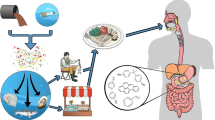Abstract
Over the past years the importance of food additives and the development of so-called novel food increased permanently. Especially, the application of dietary supplements was on the rise. Then, more and more new products based on plants hitherto not used for human consumption were launched. Algae products containing valuable amounts of essential nutrients such as amino acids and trace elements play a decisive role. On the other hand, some algae including the blue-green algae (cyanobacteria) are capable of synthesizing harmful substances depending on species and provenience. Therefore, methods must be available to evaluate possible risks caused by toxins in algae-based dietary supplements. There are different groups of toxins related to marine algae and cyanobacteria. However, both marine algae and cyanobacteria are able to produce Paralytic Shellfish Poisoning (PSP) toxins which are potential neurotoxins. Hence, analytical methods for PSP determination have to be developed. The method for PSP toxin determination described below is based on ion-pair chromatography of the underivatized PSP toxins followed by post-column oxidation and fluorescence detection (FD). The determination of very low amounts of PSP toxins in different matrices of novel food is possible. In addition, the method allows to compare PSP profiles of various algae-based dietary supplements.




Similar content being viewed by others
References
Luckas B (1992) Phycotoxins in seafood-toxicological and chromatographic aspects. J Chromatogr 624:439–456
McFarren EF, Schafer ML, Campbell JE, Lewis KH, Jensen ET, Schantz EJ (1960) Public health significance of paralytic shellfish poison. Adv Food Res 10:135–179
Steidinger KA (1993) Some taxonomic and biologic aspects of toxic dinoflagellates. In: Falconer IR (ed) Algal toxins in seafood and drinking water. Academic, London, pp 1–28
Mahmood NA,Carmichael WW (1986) Paralytic shellfish poisons produced by the freshwater cyanobacterium Aphanizomenon flos-aquae. Toxicon 24:175–186
Ferreira FM, Franco Soler JM, Fidalgo ML, Fernandez-Vila P (2001) PSP toxins from Aphanizomenon flos-aquae (cyanobacteria) collected in the Crestuma-Lever reservoir (Douro river, northern Portugal). Toxicon 39:757–761
Carmichael WW, Drapeau C, Anderson DM (2000) Harvesting and quality control of Aphanizomenon flos-aquae from Klamath Lake for human dietary use. J Appl Phycol 12:585–595
Association of Official Analytical Chemists (1990) Official methods of analysis, 15th edn. Arlington, VA, pp 881–882
Botana LM (2000) Seafood and freshwater toxins, pharmacology, physiology and detection. Marcel Dekker, New York, Basel
Oshima Y (1995) Harmful and toxic algal blooms. J AOAC Int 2:528
Sullivan JJ, Wekell MM, Kentala LL (1985) Application of HPLC for the determination of PSP toxins in shellfish. J Food Sci 50:26–29
Luckas B, Hummert C, Oshima Y (2003) Analytical methods for paralytic shellfish poisons. In: Hallegraeff GM, Anderson DM, Cembella AD (eds.) Manual on harmful marine microalgae. Oceanographic Commission of UNESCO, 7 Place de Fontenoy, 75352 Paris 07 SP, France
Author information
Authors and Affiliations
Corresponding authors
Rights and permissions
About this article
Cite this article
Diener, M., Erler, K., Hiller, S. et al. Determination of Paralytic Shellfish Poisoning (PSP) toxins in dietary supplements by application of a new HPLC/FD method. Eur Food Res Technol 224, 147–151 (2006). https://doi.org/10.1007/s00217-006-0302-4
Received:
Revised:
Accepted:
Published:
Issue Date:
DOI: https://doi.org/10.1007/s00217-006-0302-4




